Lenticular galaxies appear like flying saucers because of their distinctive edge-on view. You’ll see a prominent central bulge surrounded by a flattened disk without spiral arms, creating that classic UFO silhouette. These galaxies feature smooth, rounded edges and a lens-like profile that perfectly mimics the aerodynamic design we associate with fictional spacecraft. Their unique structure sits at the evolutionary crossroads between spiral and elliptical galaxies, holding fascinating secrets about cosmic development.
The Distinctive Lens-Like Structure of Lenticular Galaxies

Cosmic intermediaries between spiral and elliptical forms, lenticular galaxies exhibit a unique lens-like structure that sets them apart in our universe.
You’ll notice their prominent central bulge surrounded by a flattened disk region that lacks the spiral arms of their more elaborate cousins.
What gives lenticular galaxies their distinctive flying saucer appearance is their higher bulge-to-disk ratio compared to spiral galaxies. This creates their smooth, uniform profile that resembles a lens when viewed from certain angles.
When observed edge-on, they’re often mistaken for elliptical galaxies, enhancing their saucer-like appearance.
Despite their seemingly featureless disks, many lenticular galaxies retain significant amounts of dust, forming striking dust lanes that cut across their otherwise smooth structure.
These features contribute to their unique morphology that’s instantly recognizable to astronomers.
Comparing Lenticular Galaxies to UFO Shapes in Popular Culture
When viewed edge-on, lenticular galaxies bear a striking resemblance to the classic flying saucer shape that’s become iconic in UFO lore.
You’ll notice this perspective highlights their flattened disk and bulging center, creating the same distinctive silhouette that has inspired countless science fiction depictions of alien spacecraft.
This visual parallel has contributed to the cultural fascination with disk-shaped celestial objects, blurring the line between astronomical reality and extraterrestrial imagination in popular media.
Edge-on Perspective Similarities
The silhouette of a lenticular galaxy, viewed edge-on through a telescope, bears a striking resemblance to the iconic flying saucer shape embedded in our popular culture. When you observe these S0 galaxies from this viewpoint, you’ll notice the characteristic flattened disk with a prominent central bulge—precisely the profile that UFO enthusiasts would recognize.
- The edge-on perspective reveals the true disc-like nature of lenticular galaxies.
- Central bulges mimic the command center or dome of fictional flying saucers.
- Smooth, rounded edges match the aerodynamic design typically associated with UFOs.
- Absence of spiral arms creates the clean, uninterrupted silhouette reminiscent of classic alien spacecraft.
This shifting form between spiral and elliptical galaxies occupies a similar conceptual space as flying saucers do in science fiction—mysterious objects that seem to bridge different worlds.
Science Fiction Inspiration
Since their discovery, lenticular galaxies have unwittingly inspired generations of science fiction writers and filmmakers searching for the perfect alien spacecraft design. You’ll notice striking similarities between these celestial objects and the iconic flying saucer shape that’s dominated UFO depictions since the mid-20th century.
| Lenticular Feature | Flying Saucer Connection |
|---|---|
| Central bulge | Command center/bridge |
| Thin disk structure | Aerodynamic design |
| Smooth, rounded edges | Sleek, alien technology |
| Glowing appearance | Propulsion system lights |
This visual parallel has contributed to numerous UFO sightings when people mistake lenticular clouds for spacecraft. The resemblance isn’t coincidental—our imagination naturally draws connections between the unknown cosmic structures and hypothetical alien technology, creating a fascinating intersection of astronomy and science fiction that continues to influence how we envision extraterrestrial visitors.
The Science Behind the Flying Saucer Appearance
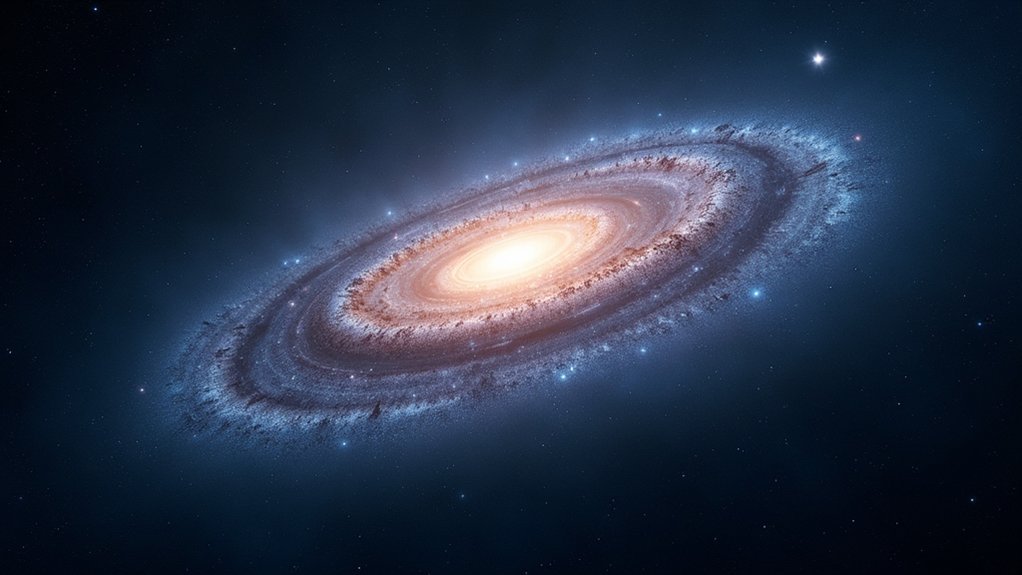
When you observe lenticular galaxies from an edge-on viewing perspective, their flattened disk structure creates a distinctive flying saucer silhouette familiar in UFO accounts.
Their higher bulge-to-disk ratio compared to spiral galaxies produces the characteristic lens shape that inspired their classification as S0 types in the Hubble sequence.
The light distribution patterns across these galaxies reveal a smooth, uniform appearance dominated by older stars, which contributes to their solid, defined outline against the darkness of space.
Edge-on Viewing Perspective
Viewed from the edge, lenticular galaxies transform into one of astronomy’s most enchanting sights—celestial structures remarkably similar to flying saucers from science fiction.
When you’re observing lenticular galaxies from this angle, their distinctive bulge-disk ratio becomes immediately apparent. Unlike spiral galaxies, which contain pronounced spiral arms, these S0 classified galaxies reveal their changing nature through their lens-shaped profile.
The prominent central bulge contrasts sharply with the flattened disk, creating that iconic flying saucer silhouette.
- Central bulge appears as the “cockpit” of the cosmic saucer
- Smooth, featureless disk extends outward with clean edges
- Lack of spiral structure enhances the sleek, saucer-like appearance
- Higher bulge-disk ratio creates more pronounced lens shape than in spiral galaxies
Galactic Disk Structure
The distinctive flying saucer appearance of lenticular galaxies stems directly from their unique disk structure. When you observe these galaxies edge-on, you’ll notice their flat, lens-shaped profile that creates the unmistakable flying saucer silhouette. Unlike spiral galaxies, lenticulars don’t have prominent spiral arms, giving them a smoother, more uniform appearance.
| Feature | Characteristic | Visual Effect |
|---|---|---|
| Disk | Thin, extended | Saucer-like edge |
| Bulge | Prominent, spherical | Central dome |
| Star distribution | Concentrated in bulge | Bright center |
| Dust content | Minimal, diffuse | Hazy outline |
| Bulge-to-disk ratio | Higher than spirals | Accentuated lens shape |
The high bulge-to-disk ratio in lenticular galaxies is particularly important—this proportion creates the distinctive lens shape that astronomers find so compelling, enhancing their resemblance to the classic flying saucer of science fiction.
Light Distribution Patterns
Although astronomers classify galaxies primarily by shape, it’s the distinctive light distribution patterns in lenticular galaxies that create their iconic flying saucer appearance.
When you observe these galaxies, you’ll notice their light isn’t randomly scattered but follows specific structural rules.
The bulge-to-disk ratio in lenticular galaxies creates that unmistakable lens-like profile. Unlike spirals with their dramatic arms, these galaxies showcase:
- Concentrated luminosity in the central bulge, creating a bright core
- Smooth progression of light from center to edges
- Sharp edge-on profiles that enhance the saucer appearance
- Dust lanes that sometimes create striking visual bands across the disk structure
This unique light distribution creates pressure-supported structures that maintain the galaxy’s distinctive shape, making lenticulars some of the most visually striking objects in our universe.
Historical Observations and Discovery of Lenticular Galaxies
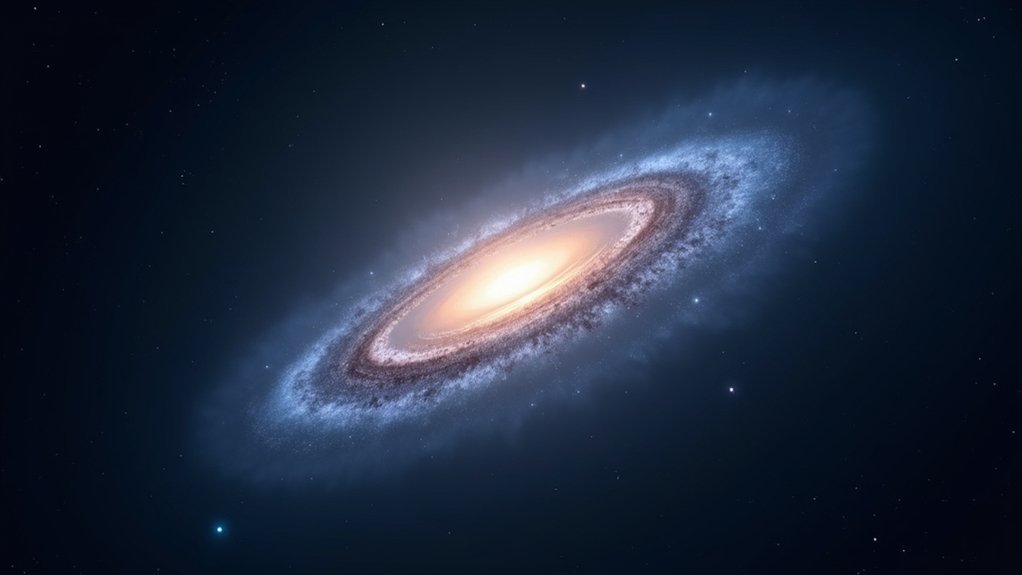
Historical observations of lenticular galaxies date back to the 1920s when Edwin Hubble first classified them within his revolutionary morphological framework. He designated these unique celestial objects as S0 types, recognizing them as developmental forms between spiral and elliptical galaxies.
You’ll find lenticular galaxies characterized by their distinctive disk structure without spiral arms, paired with a prominent bulge.
One of the most famous examples you might recognize is NGC 5866, known as the Spindle Galaxy. This striking specimen has helped astronomers understand the evolutionary relationship between different galaxy types.
The classification scheme Hubble developed has proven remarkably enduring, allowing scientists to document the prevalence of lenticular galaxies throughout our nearby universe. Recent discoveries of supermassive black holes within some lenticular galaxies have further enhanced our understanding of their formation and dynamics.
How Lenticular Galaxies Differ From Spiral and Elliptical Galaxies
When examining the celestial landscape, you’ll notice that lenticular galaxies occupy a fascinating middle ground in the cosmic hierarchy.
These disk-shaped objects with central bulges lack the distinctive spiral arms that define spiral galaxies, yet maintain a disk structure unlike pure elliptical galaxies.
Unlike their spiral counterparts, lenticulars contain mainly older stars with minimal ongoing star formation, resembling elliptical galaxies in stellar composition. Their higher bulge-to-disk ratio further highlights their shifting nature.
Lenticular galaxies: cosmic intermediaries with aged stellar populations and prominent bulges, bridging the divide between spirals and ellipticals.
- While elliptical galaxies generally lack dust and gas, lenticular galaxies may retain significant amounts in their disks
- Lenticulars can display structural features like bars or rings despite minimal star formation
- Spiral galaxies showcase prominent arm structures that lenticulars don’t possess
- They’re believed to be either faded spirals or merger products, explaining their hybrid characteristics
Famous Examples of Saucer-Shaped Galaxies in Our Universe
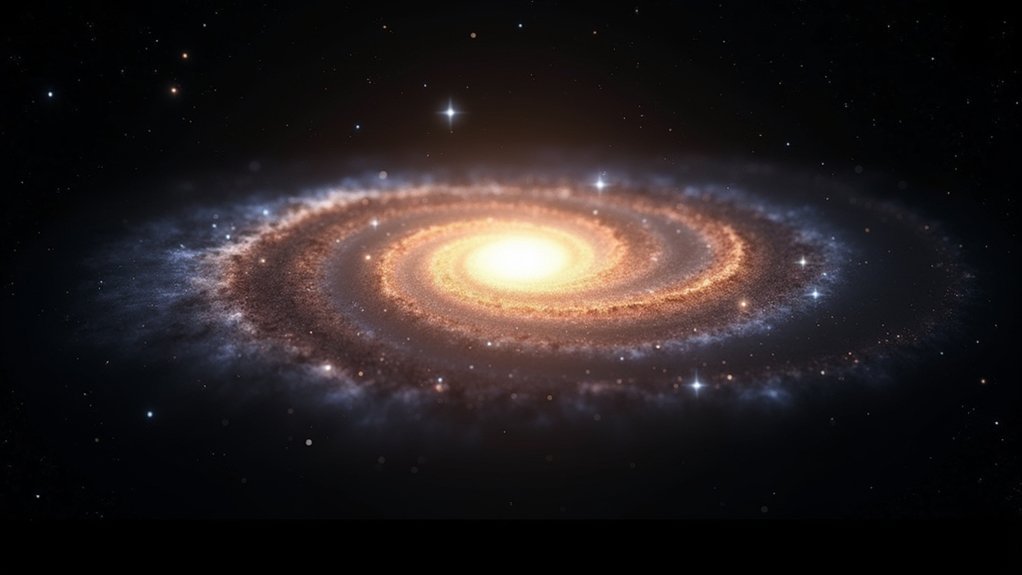
Several striking lenticular galaxies capture astronomers’ attention with their distinctive saucer-like profiles. NGC 5866, aptly named the Spindle Galaxy, presents a perfect edge-on view that epitomizes the flying saucer appearance. Its lens-like structure makes it a textbook example found in many galaxy clusters.
NGC 3115 stands out with its prominent central bulge – a hallmark feature that defines the lenticular classification. Similarly, NGC 2787 exhibits the classic disk-and-bulge structure that reinforces the saucer analogy when observed from Earth.
The Cartwheel Galaxy, though famous for its ring structure, contains lenticular elements that contribute to its unusual appearance.
NGC 4921, an anemic spiral, blurs classification boundaries with its lenticular characteristics. Hubble Space Telescope observations continue to reveal these galaxies’ structural nuances.
The Stellar Composition That Creates the Disk-Like Appearance
The stellar composition within lenticular galaxies directly determines their distinctive disk-like structure that astronomers observe.
When you’re looking at these cosmic saucers, you’re seeing mainly older red stars—typically over a billion years old—arranged in a way that highlights the flat disk and prominent central bulge.
Unlike their spiral cousins, lenticular galaxies feature:
- Higher bulge-to-disk ratios emphasizing their flatness
- An absence of gas needed for new star formation
- Older stellar populations creating the reddish hue
- Dusty disk structures without defined spiral arms
The combination of these elements creates the lens-like appearance you see when observing S0 galaxies edge-on.
Their unique stellar populations and structural composition contribute to that flying saucer shape that’s captured astronomers’ imagination for decades.
Evolution and Formation Theories of These Cosmic Disks
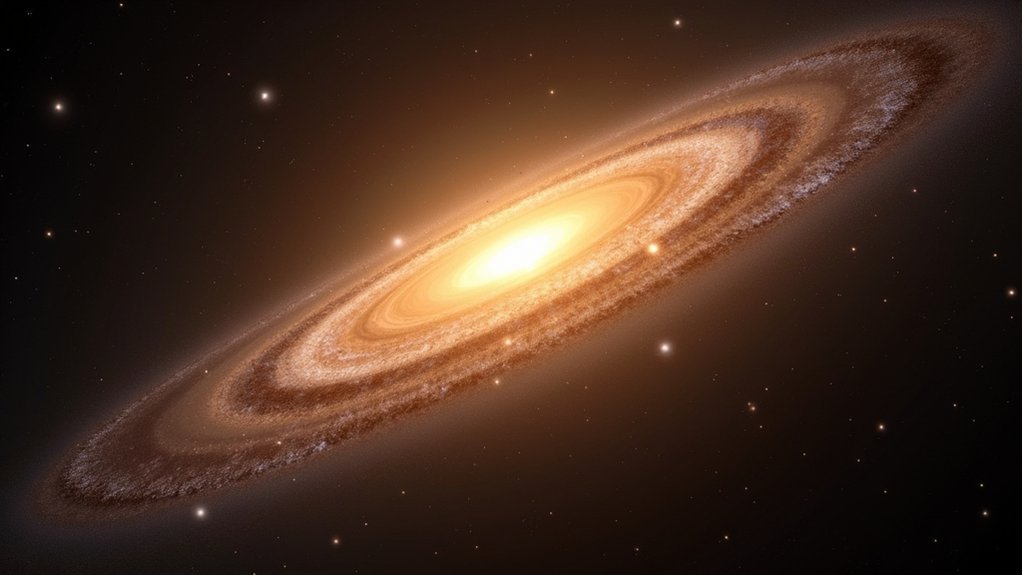
Despite their seemingly static appearance, lenticular galaxies tell a dynamic evolutionary story that astronomers have pieced together through decades of observation and modeling.
You’re looking at cosmic structures that likely began as spiral galaxies before exhausting their gas and dust reserves, causing star formation to decline and spiral arms to fade away.
Galaxy formation pathways for these disk-shaped objects often involve major mergers that redistribute stellar populations, creating the prominent bulges characteristic of lenticular galaxies.
Major galaxy mergers sculpt lenticular systems, redistributing stars into their distinctive bulge-dominated structure.
Their higher bulge-to-disk ratios compared to spirals support this developmental classification between spiral and elliptical types.
The offset in the Tully-Fisher relation further confirms their spiral origins, while residual dust lanes alongside aging stars reveal how these systems continue their passive evolution while maintaining their distinctive flying saucer shape.
Observing Lenticular Galaxies Through Amateur Telescopes
While astronomers study the formation and evolution of lenticular galaxies through massive telescopes and sophisticated simulations, you don’t need professional equipment to appreciate these cosmic hybrids yourself.
These flying saucer-shaped objects reveal themselves best when viewed edge-on, highlighting their distinctive disk and notable central bulge.
You’ll find these galaxies particularly fascinating because of their:
- Low star formation rates, evidenced by mainly red stars
- Position between spiral and elliptical galaxies in the Hubble sequence
- Unique disk structure without spiral arms
- Minimal interstellar gas compared to other galaxy types
Look for NGC 5866 and NGC 2787 as excellent starter targets. Use star charts or astronomy apps to locate these objects, and remember that darker skies greatly improve your chances of spotting these celestial wonders.
Why Astronomers Find These “Cosmic Saucers” Fascinating
You’ll find astronomers captivated by lenticular galaxies because they represent cosmic evolution‘s missing link, bridging the gap between spiral and elliptical formations.
Their unique structure—combining a disk without spiral arms and a prominent bulge—offers essential clues about how galaxies transform throughout the universe’s timeline.
These “cosmic saucers” reveal shift mysteries that help scientists piece together the complete story of galactic evolution, from star formation histories to the effects of galaxy mergers.
Structural Transition Mysteries
Among the most enigmatic objects in our universe, lenticular galaxies captivate astronomers with their unique “cosmic saucer” appearance that defies simple classification.
The structure of these celestial objects represents a fascinating evolutionary puzzle, sitting at the crossroads between spiral and elliptical galaxies.
When you examine the formation of a lenticular galaxy, you’ll find evidence of their developmental nature in several key characteristics:
- Higher bulge-to-disk ratios than spiral galaxies, creating their distinctive flying saucer profile
- Absence of spiral arms despite maintaining a prominent disk structure
- Minimal ongoing star formation activity compared to their spiral counterparts
- Presence of significant dust in their disks, unlike typical elliptical galaxies
This structural ambiguity makes lenticular galaxies particularly valuable for understanding galactic evolution through mergers or spiral fading processes.
Evolution’s Missing Link
For decades, astronomers have considered lenticular galaxies the evolutionary “missing link” in our understanding of galactic transformation. When you observe these S0 galaxies, you’re witnessing cosmic structures caught between two major galaxy types.
| Feature | Spiral Galaxies | Lenticular Galaxies | Elliptical Galaxies |
|---|---|---|---|
| Arms | Prominent | Absent | Absent |
| Disk | Present | Present | Absent |
| Bulge | Moderate | Prominent | Dominant |
| Star Formation | Active | Minimal | Minimal |
| Gas Content | High | Low | Very Low |
Lenticular galaxies fascinate researchers because they provide essential insights into galaxy evolution pathways. These flying saucer-shaped objects likely represent what happens when spirals exhaust their gas reserves and stop forming stars. Some S0 galaxies also show evidence of past mergers, with dust features that distinguish them from their elliptical cousins.
Frequently Asked Questions
What Type of Galaxies Have the Shape of a Flying Saucer?
You’ll find that lenticular galaxies have flying saucer shapes. They’re classified as S0 galaxies with a prominent central bulge and flat disk structure but lack spiral arms, giving them that distinctive UFO-like appearance.
What Cloud Looks Like a Flying Saucer?
You’re likely thinking of lenticular clouds. They’re lens-shaped formations that appear above mountains when moist air flows over terrain. Their smooth, oval shape often resembles flying saucers, leading to many UFO misidentifications throughout history.
What Do Lenticular Galaxies Look Like?
You’ll recognize lenticular galaxies by their lens-like shape with a bright central bulge surrounded by a flat disk. They’re smooth without spiral arms, appearing like flying saucers when viewed from the side.
What Is the Most Striking Visual Feature of This Lenticular Galaxy?
The most striking visual feature you’ll notice is the prominent dust lane cutting across NGC 5866’s disk. It creates a dramatic contrast against the bright bulge, enhancing its distinctive flying saucer appearance.
In Summary
You’ve now seen how lenticular galaxies earn their flying saucer nickname through their distinctive disk and bulge structure. They’re not just visually striking—they’re fascinating intermediary objects in cosmic evolution. Next time you’re stargazing, look for these cosmic UFOs. They’ll remind you that the universe’s most intriguing mysteries often come in shapes that spark our imagination and scientific curiosity.

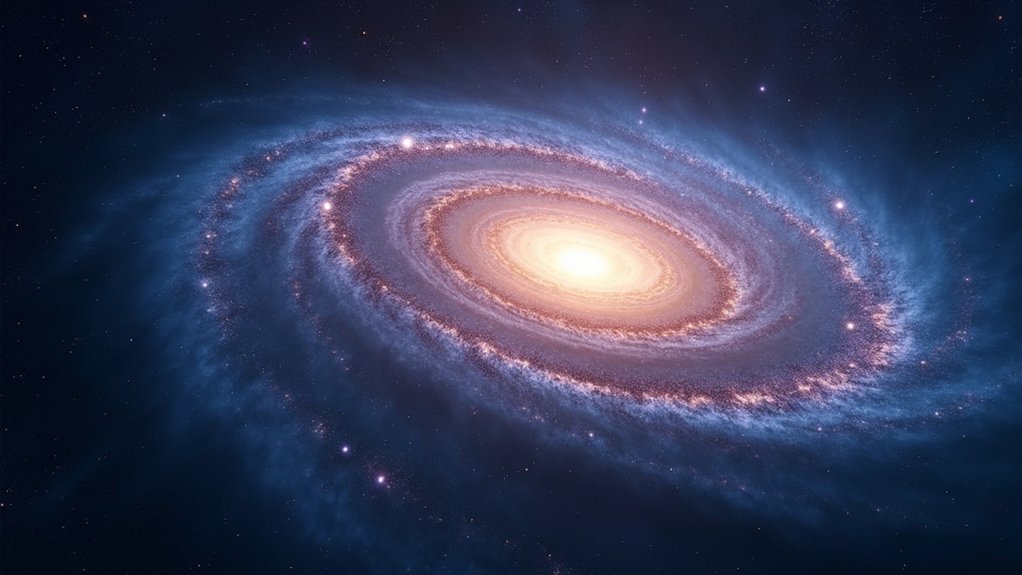


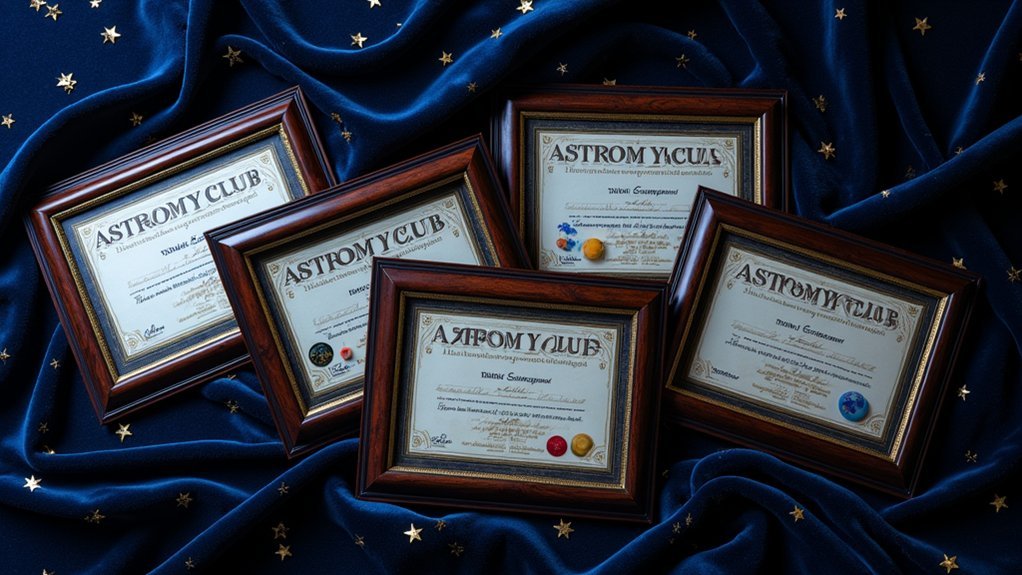
Leave a Reply